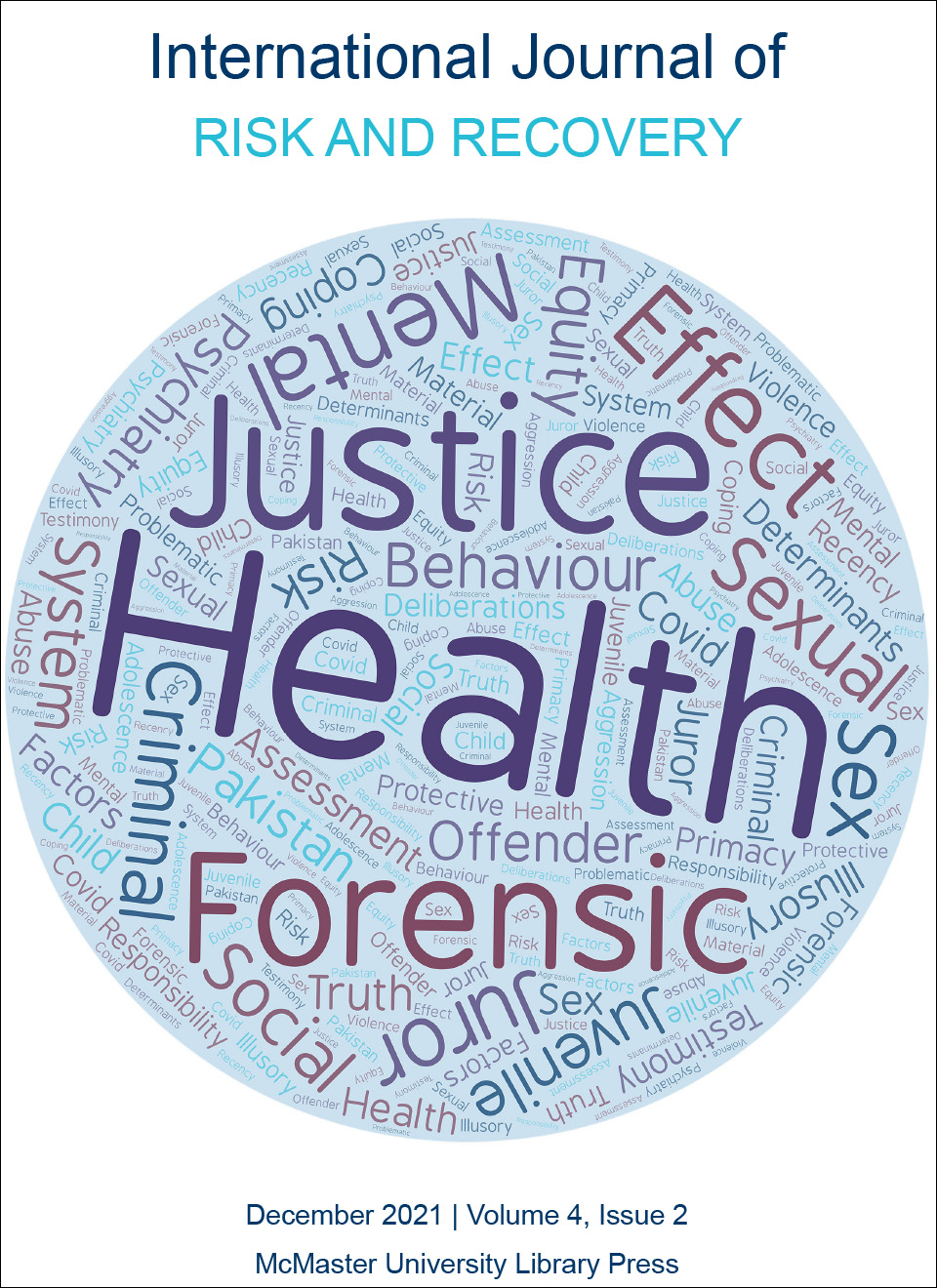UNE ENQUÊTE SUR L'IMPACT DE L'EFFET DE VÉRITÉ ILLUSOIRE SUR LE PROCESSUS DE PRISE DE DÉCISION DES JURORS: EST-IL MIEUX D'ÊTRE TÔT OU TARD QUAND IL S'AGIT D'UNE PREUVE CRITIQUE?
DOI :
https://doi.org/10.15173/ijrr.v4i1.4339Mots-clés :
ITE, testimony, juror deliberations, primacy effect, recency effect, illusory truth effectRésumé
L'effet de vérité illusoire (ITE) est la tendance à croire que les fausses informations sont aussi exactes après avoir été présentées à plusieurs reprises au fil du temps. Il a été démontré que l'ITE est vrai dans de nombreux contextes différents, mais aucune étude n'a examiné l'influence de l'ITE dans le cadre de la délibération des jurés. Compte tenu de l'importance de peser les faits juridiquement pertinents dans le processus décisionnel et de l'influence potentielle des ITE, cette étude a examiné si la manipulation (c'est-à-dire la répétition) des preuves clés dans les témoignages est importante dans ce contexte. De plus, cette étude a examiné si les informations critiques seraient influencées par l'emplacement de l'ITE. Dans ce contexte, les informations critiques peuvent être affectées différemment en introduisant l'ITE tôt (c'est-à-dire l'effet de primauté) ou plus tard (c'est-à-dire l'effet de récence) dans le processus décisionnel. Afin d'examiner cet effet, les participants (n = 100) ont été recrutés et invités à lire une vignette où les preuves essentielles relatives à un crime étaient stratégiquement répétées tout au long du récit de l'affaire. Les participants ont été répartis dans l'un des quatre groupes: 1- contrôle; 2- ITE tout au long de la vignette; 3- ITE au début de la vignette; et 4- ITE à la fin de la vignette. Après avoir lu la vignette, les participants ont été invités à remplir un court questionnaire et à fournir une décision finale concernant divers aspects du cas. Les résultats ont révélé que la répétition de preuves critiques est importante. De plus, le placement de preuves critiques a le potentiel d’influencer la perception des jurés de certains détails pertinents. Ces conclusions suggèrent que, dans un contexte sensible, tel qu’un jury évaluant la culpabilité d’un accusé, l’ITE pourrait modifier sa perception des éléments de preuve.
Références
Gold V. Psychological manipulation in the courtroom. Nebraska Law Review. 1987;66(3):563-583. https://digitalcommons.unl.edu/nlr/vol66/iss3/11/.
Tanford S, Penrod S. Jury deliberations: Discussion content and influence processes in jury decision making. Journal of Applied Social Psychology. 1986;16(4):322-347. https://doi.org/10.1111/j.1559-1816.1986.tb01144.x.
Hasher L, Goldstein D, Roppino T. Frequency and the conference of referential validity. Journal of Verbal Learning and Verbal Behavior. 1977;16(1);107-112. https://doi.org/10.1016/S0022-5371(77)80012-1.
Wang W, Brashier N, Wing E, Marsh E, Cabeza R. On known unknowns: Fluency and the neural mechanisms of illusory truth. Journal of Cognitive Neuroscience. 2016;28(5):739-746. https://doi.org/10.1162/jocn_a_00923.
Fazio L, Brashier N, Payne B, Marsh E. Knowledge does not protect against illusory truth. Journal of Experimental Psychology: General. 2015;144(5):993-1002. https://doi.org/10.1037/xge0000098.
Gigerenzer G, Gaissmaier W. Heuristic decision making. The Annual Review of Psychology. 2011;62:451-82. https://doi.org/10.1146/annurev-psych-120709-145346.
Unkelbach C, Rom S. A referential theory of the repetition-induced truth effect. Cognition. 2017;160:110-126.
https://doi.org/10.1016/j.cognition.2016.12.016.
DiFonzo N, Beckstead J, Stupak N, Walders K. Validity judgments of rumors heard multiple times: The shape of the truth effect. Social Influence. 2016;11(1):22-39. https://doi.org/10.1080/15534510.2015.1137224.
Oppenheimer D.M. The secret life of fluency. Trends in Cognitive Sciences. 2008;12(6):237-241. https://doi.org/10.1016/j.tics.2008.02.014.
Dechêne A, Stahl C, Hansen J, Wänke M. The truth about the truth: A meta-analytic review of the truth effect. Personality and Social Psychology Review. 2009;14(2):238-257. https://doi.org/10.1177/1088868309352251.
Henkel L, Mattson M. Reading is believing: The truth effect and source credibility. Consciousness and Cognition. 2011;20(4):1705-1721. https://doi.org/10.1016/j.concog.2011.08.018.
Belcher A, Sinnott-Armstrong W. Neurolaw. Wiley Interdisciplinary Reviews. Cognitive Science. 2009;1(1):18-22. https://doi.org/10.1002/wcs.8.
Jones O, Marois R, Farah M, Greely H. Law and neuroscience. The Journal of Neuroscience. 2013;33(45):17624-17630. https://doi.org/10.1523/JNEUROSCI.3254-13.2013.
Morrison AB, Conway ARA, Chein JM. Primacy and recency effects as indices of the focus of attention. Frontiers in Human Neuroscience. 2014;24:1-14. https://doi.org/10.3389/fnhum.2014.00006.
Highhouse S, Gallo A. Order effects in personnel decision making. Human Performance. 1997;10(1):31-46.
https://doi.org/10.1207/s15327043hup1001_2.
Marsh J, Ahn W. Order effects in contingency learning: The role of task complexity. Memory & Cognition. 2006;34(3):568-576.
https://doi.org/10.3758/BF03193580.
Dennis M, Ahn W. Primacy in causal strength judgments: The effect of initial evidence for generative versus inhibitory relationships. Memory & Cognition. 2001;29(1):152-164. https://doi.org/10.3758/BF03195749.
R. v. Kionke, 2017 MBQB 60 (CanLII).https://www.canlii.org/en/mb/mbqb/doc/2017/2017mbqb60/2017mbqb60.html.
Leippe M, Eisenstadt D, Rauch S, Seib H. Timing of eyewitness expert testimony, jurors’ need for cognition, and case strength as determinants of trial verdicts. Journal of Applied Psychology. 2004;89(3):524-541. https://doi.org/10.1037/0021-9010.89.3.524.
Miller N, Campbell D. Recency and primacy in persuasion as a function of the timing of speeches and measurements. Journal of Abnormal and Social Psychology. 1959;59(1):1-9. https://doi.org/10.1037/h0049330.
Brewer P, Ley B. Media use and public perceptions of DNA evidence. Science Communication. 2009;32(1):93-117. https://doi.org/10.1177/1075547009340343.
Téléchargements
Publié-e
Comment citer
Numéro
Rubrique
Licence
(c) Tous droits réservés Alexandrea Johnston, Daniel Ambrosini, Bruno Losier 2021

Cette œuvre est sous licence Creative Commons Attribution 3.0 non transposé.
Copyright Notice
Authors who publish with this journal agree to the following terms:
- Authors retain copyright of their work and grant the International Journal of Risk and Recovery the right of first publication with the work simultaneously licensed under a Creative Commons Attribution License. This allows others to share the work with an acknowledgement of the work’s authorship and initial publication in this journal.
- Authors are able to enter into separate, additional contractual arrangements for the non-exclusive distribution of the journal’s published version of the work (e.g., post it to an institutional repository or publish it in a book) with an acknowledgement of its initial publication in this journal.
- Authors are permitted and encouraged to post their work online (e.g., in institutional repositories or on their websites) before and during the submission process as it can lead to productive exchanges, as well as earlier and greater citation of published work. (See The Effect of Open Access.)

